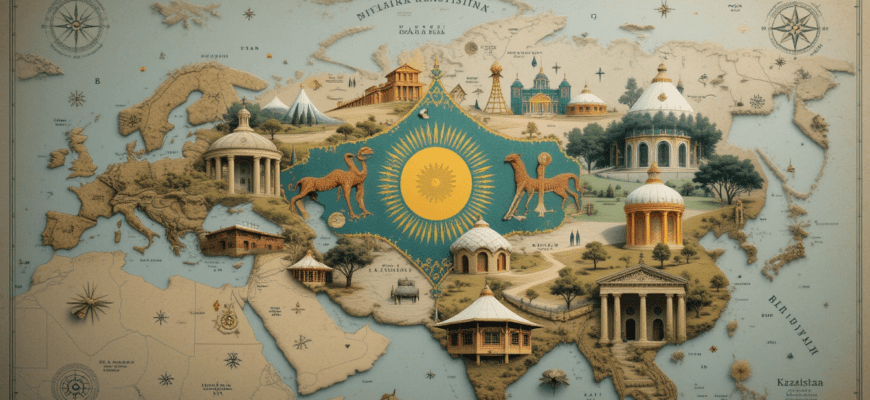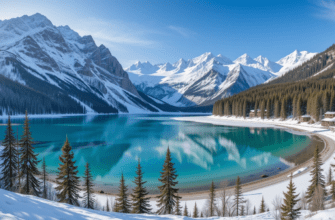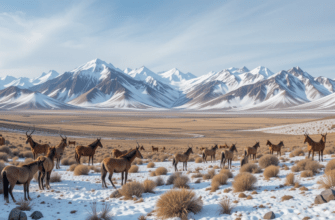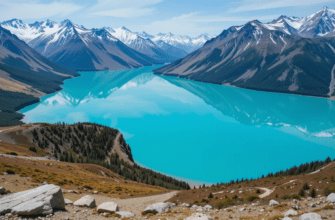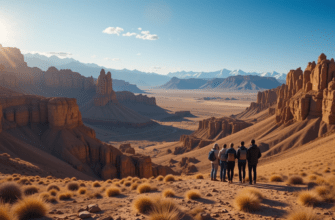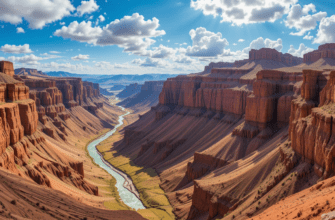- Key Highlights
- Introduction
- The Geographic Crossroads of Kazakhstan
- Straddling Continents: A Geographical Overview
- Mountains, Steppes, and Rivers: The Natural Tapestry
- Historical Journey: From Nomads to Nationhood
- Early Civilizations and Silk Road Significance
- The Impact of Russian and Soviet Rule
- Independence and National Identity
- Political Landscape: Governance in Kazakhstan
- The Structure of Government Today
- Kazakhstan in International Relations
- Progress and Challenges in Human Rights
- Economic Perspectives: Between Europe and Asia
- Key Industries and Economic Partners
- The Role of Oil and Gas
- Initiatives for Economic Diversification
- Social Fabric: People and Culture
- Ethnic Diversity and Linguistic Richness
- Religious Practices and Interfaith Harmony
- Cultural Expressions in Literature and Art
- Educational and Scientific Endeavors
- The Education System and Its Evolution
- Achievements and Innovations in Science and Technology
- Environmental Concerns and Actions
- Addressing Climate Change and Conservation
- Sustainable Development Goals and Green Initiatives
- Kazakhstan’s International Sporting Achievements
- Prominent Sports and Athletes
- Hosting International Competitions
- Tourism: Exploring Kazakhstan’s Charm
- UNESCO World Heritage Sites and Natural Wonders
- The Silk Road Legacy: A Tourist Revival
- Culinary Journey: From Traditional to Contemporary
- Staple Foods and Signature Dishes
- The Influence of Silk Road on Kazakh Cuisine
- Media and Freedom of Expression
- The Landscape of Media in Kazakhstan
- Digital Media Growth and Government Regulations
- The Debate: Is Kazakhstan More European or Asian?
- Historical Ties and Cultural Leanings
- Economic Integration and Geopolitical Alliances
- Future Directions: Kazakhstan’s Path Forward
- Vision 2050 and Strategic Development Goals
- Balancing Tradition with Modernization
- Conclusion
- Frequently Asked Questions
- How does Kazakhstan balance its European and Asian identities?
- What are Kazakhstan’s major contributions to the global stage?
- How has Kazakhstan’s history shaped its current policies?
- What initiatives is Kazakhstan taking towards environmental sustainability?
- Can tourists experience both European and Asian influences in Kazakhstan?
Key Highlights
- Kazakhstan, the world’s largest landlocked country, straddles the geographical divide between Europe and Asia.
- Historically, the region was a crossroads of civilizations, shaped by nomadic empires, the Silk Road, and Soviet rule.
- Kazakhstan boasts a diverse population, rich cultural heritage, and an economy largely driven by its vast natural resources, particularly oil and gas.
- Since independence in 1991, the country has pursued a multi-vector foreign policy, balancing relations with the East and West.
- As a rising player on the global stage, Kazakhstan continues to navigate its complex identity and development trajectory.
Introduction
The Republic of Kazakhstan, which occupies a vast territory of Kazakhstan in the center of Central Asia, is a special country that people often discuss, including insights from the Central Intelligence Agency. As the largest country in the Commonwealth of Independent States (CIS) region, it spreads across two continents. It has wide steppes, modern cities, and many different cultures. This raises an interesting question: is it more a part of Europe or Asia? Join us as we explore the many sides of Kazakhstan’s identity.
The Geographic Crossroads of Kazakhstan
Kazakhstan’s land shows its complicated identity. This huge country, with an area of several square kilometres, is bigger than Western Europe. It has many different landscapes. You can find tall, snowy mountains like the Tian Shan in the east. The west has dry plains. These physical features show that it sits at the meeting point of continents.
Straddling Continents: A Geographical Overview
The Ural River separates Europe and Asia. It runs through Kazakhstan, so part of Kazakhstan is in Eastern Europe. But most people see Kazakhstan as part of Central Asia. To the north is Russia, to the east is China, and several other Central Asian countries are to the south. This makes Kazakhstan a link between these areas. The country also borders the Caspian Sea. The Caspian Sea is the biggest inland body of water in the world. This all shows Kazakhstan’s unique spot at a crossroad of continents, especially considering its total area relative to its geographical significance.
Mountains, Steppes, and Rivers: The Natural Tapestry
The territory of central Kazakhstan is very diverse. In the east, there are high mountain ranges like the Altai and Tian Shan. In the center and west, the huge Kazakh steppe stretches out, which includes vast stretches of arable land, comprising hundreds of cubic feet of fertile soil. This wide area of grassland has influenced the nomadic way of life and culture of the Kazakh people for many years. Major rivers, such as the Irtysh and the Syr Darya, run through this different landscape. They flow into Lake Balkhash, which is special because it has both fresh and salty water.
Historical Journey: From Nomads to Nationhood
Kazakhstan has a fascinating history, just like its landscape. It has seen ancient nomadic tribes moving across the steppes and has spent many years under Soviet rule. The nation has experienced the rise and fall of many empires. This has significantly impacted its identity. These influences still affect Kazakhstan today and will shape its future.
Early Civilizations and Silk Road Significance
The land we now call Kazakhstan has had people living in it since the Paleolithic era. Over time, many nomadic empires have come and gone, including the Mongol Empire led by Genghis Khan. This area is also important because it is along the Silk Road, which is the old trade route linking the East and West. This location helped the region grow and connect cultures. The Kazakh tribes became a separate ethnic group in the 15th century. This was an important change in the history of the country. The Kazakhs are famous for their horse riding skills and their nomadic way of life. They created strong khanates, which are like kingdoms, and these changed the politics and society in the area.
The Impact of Russian and Soviet Rule
In the 18th century, the Russian Empire grew into Central Asia. This change led to Kazakhstan becoming part of Russia. During this time, there were big social and cultural shifts. The Russian language was introduced, and many Russian settlers, including Crimean Tatars, moved in. After the Bolshevik Revolution, Kazakhstan became an autonomous republic and a Soviet republic in 1936. Under Soviet rule, there was fast growth in industry and changes in farming. However, it also meant less support for Kazakh culture and language. This time was marked by terrible events, like the forced famine in the 1930s and the damage to the Aral Sea. Still, the Soviet period helped build Kazakhstan’s modern roads and schools.
Independence and National Identity
With the collapse of the Soviet Union in 1991, the Republic of Kazakhstan declared its independence. This was the start of a new period in its history. Nursultan Nazarbayev, the first president of Kazakhstan, guided Kazakhstan through a time of change after the Soviet era, focusing on political stability and economic growth, while President Nazarbayev and President Tokayev emphasized the importance of these elements.
One key move he made was relocating the capital from Almaty to Astana, now called Nur-Sultan. This change was a way to modernize the country and show its independence. Since becoming independent, Kazakhstan has worked on building its national identity. It has promoted the Kazakh language and encouraged economic development. The country has also adopted a foreign policy that connects it with both the West and the East while keeping strong ties with Russia.
National statistics show the great progress in areas like education, healthcare, and economic growth. This has helped Kazakhstan become a leader in its region by utilizing its vast land area as it steps into the 21st century.
Political Landscape: Governance in Kazakhstan
Kazakhstan’s politics have changed since it became independent from the Soviet Union. This change is due to its specific location and global situation. The country has grown its economy and improved relations with other nations. However, the way it is governed has received both good and bad feedback from people around the world.
The Structure of Government Today
The Government of Kazakhstan works as a presidential republic. Here, the President has a lot of power. There is a Prime Minister, but the President still has the most say in decisions. The Parliament has two houses and is involved in making laws; however, there are doubts about its independence. In the last few years, the government, including opposition representatives from parties like the Communist Party, has made some changes to tackle corruption and increase transparency. Still, there are challenges to fully create a democratic system with checks and balances, which is something international groups often look at closely.
Kazakhstan in International Relations
Kazakhstan knows its important position and economic chances. That’s why it has a smart plan for dealing with other countries. It keeps a strong relationship with Russia, its long-time ally and key economic partner. At the same time, Kazakhstan works with international groups like the United Nations and the European Union to improve its role worldwide. Being a part of the Shanghai Cooperation Organisation and participating in a customs union with Russia shows its rising power in Central Asia and its goal to balance relations between the East and the West. The Kazakh Foreign Minister is key in handling these complicated global issues. He supports talks and teamwork on the world stage.
Progress and Challenges in Human Rights
Kazakhstan is working to better its human rights record. They have joined international agreements and are talking with groups like the European Commission about important issues, such as the rule of law and freedom of expression. Still, there are challenges. Freedom of the press, political disagreement, and LGBTQ+ rights need attention. International groups keep a close eye on these issues. They ask the government to fix these problems and protect the basic rights of all people. Although Kazakhstan has made some progress in matching its laws with international standards, there is still work to do. The Ministry of Justice is important in pushing for legal changes and improving human rights in the country.
Economic Perspectives: Between Europe and Asia
Kazakhstan’s economy shows how important its location is between Europe and Asia. The country has many natural resources. It is now a top energy producer and exporter. This attracts foreign investment and helps economic growth. Still, it is important for Kazakhstan to diversify. This will help create a sustainable future and lessen the heavy dependence on its energy sector.
Key Industries and Economic Partners
Kazakhstan mainly exports oil and gas. However, the country is working hard to grow its economy in other areas. It is focusing on agriculture, mining, and manufacturing. Foreign direct investment is important for these sectors. It invites companies that want to use Kazakhstan’s many resources and expanding market. The shift to a market economy has gone well so far. The private sector is becoming more crucial for economic growth. The government tries to attract foreign investment. It also works to make the business environment better and to encourage new businesses.
The Role of Oil and Gas
Kazakhstan has a lot of oil and gas, which has helped its economy grow. The country exports a large amount of oil each year, sending millions of cubic metres of crude oil and oil exports to other countries. The gas industry is also important. It helps meet local energy needs and brings in money from exports. However, Kazakhstan knows it must move away from relying only on fossil fuels. The country is working to create renewable energy sources to have a better energy mix for the future. This change aims to lower environmental damage and make Kazakhstan a more responsible energy player in the world.
Initiatives for Economic Diversification
The government knows it needs to change its economy. It wants to depend less on money from oil. They have started new projects to support businesses that are not in oil, including agricultural products. This includes helping farmers grow better food, bringing in money for energy and tech, and supporting small and medium-sized businesses. The aim is to build a stronger and better economy for the future.
Kazakhstan is also working with other countries. They are part of the Eurasian Economic Union. This union helps member states trade and work together better. These actions will help improve trade, bring in foreign money, and support economic growth over time.
Social Fabric: People and Culture
Kazakhstan’s community is very diverse and lively, just like its land. The country is home to more than 130 ethnic groups, with the largest city being a vibrant center of this mix of cultures, languages, and traditions. This rich blend of people comes together because of their shared history and their goal to create a friendly and balanced society.
Ethnic Diversity and Linguistic Richness
Kazakhstan has always been a meeting point of different cultures. It has a rich mix of ethnic groups that add to its diversity. From the time of the Kazakh Khanate to the Soviet era and beyond, many people from groups like Russians, Uzbeks, and Ukrainians have shaped the country’s culture. This mix is also seen in the languages spoken there. Kazakh is the official language, but many people still use Russian. This shows how the two languages reflect the country’s history and cultural ties. The government is working hard to promote the Kazakh language in schools and offices. This helps to bring new life to the Kazakh language while also valuing Russian in society.
Religious Practices and Interfaith Harmony
Islam is the most common religion in Kazakhstan. However, the country has a mix of many other religions, including Christianity and Judaism. The constitution supports this mix by allowing freedom of religion for all its citizens. Kazakhstan encourages people from different faiths to talk to each other and respect one another. It serves as an example for interfaith teamwork in Central Asia and elsewhere. The country has held many international meetings to promote religious tolerance and stop extremism. These actions show Kazakhstan’s dedication to building a place where different beliefs can live together peacefully and help the country grow.
Cultural Expressions in Literature and Art
Kazakhstan’s culture has strong connections to its nomadic past and its role as a meeting place for different civilizations. The Kazakh steppe, with its wide open spaces and traditional ways of living, has sparked creativity in poets, writers, and musicians for many years. Epic poems and songs, shared through oral traditions, celebrate the nomadic way of life, the beauty of the land, and values like hospitality and strength. Today’s art in Kazakhstan is influenced by both old designs and modern styles, showing how its identity changes over time. Kazakh art includes detailed carpets, textiles, bright paintings, and sculptures. These forms express the depth of its cultural background while also welcoming new ideas. This exciting mix of tradition and modernity highlights the country’s artistic energy, both at home and abroad.
Educational and Scientific Endeavors
Kazakhstan understands that education and science are very important for progress. Since becoming independent, the country has spent a lot of money on these fields. They have improved schools and encouraged research and new technology. The goal is to develop a skilled workforce and become a knowledge-based economy.
The Education System and Its Evolution
Kazakhstan has made important changes to its education system. The goal is to enhance the quality of learning at all levels and match international standards. The government wants to make education available to everyone, especially in rural areas. It also encourages technical and vocational training to support a growing economy. Working with international institutions and using new teaching methods are important parts of these changes. The National Bank of Kazakhstan supports educational projects that improve financial literacy and entrepreneurship for young people. These actions show the country’s aim to give its people the knowledge and skills to succeed in a fast-changing world.
Achievements and Innovations in Science and Technology
Kazakhstan has a rich history of scientific successes. One major achievement is its important role in space exploration. The Baikonur Cosmodrome is the world’s first and largest space launch site. This site shows Kazakhstan’s strength in science. It was here that Yuri Gagarin, the first person in space, launched into orbit.
Today, Kazakhstan still takes part in global space exploration. The government works hard to grow science and technology. They invest in research and development, and they encourage new ideas. These efforts focus on areas like renewable energy, information technology, and biotechnology. This aligns with the country’s goals to diversify its economy and develop sustainably.
Environmental Concerns and Actions
Kazakhstan is a country with a large and varied environment, characterized by hot summers. It deals with special environmental problems. These come from the damage done during the Soviet era and the effects of climate change. The country is working to solve these issues. It wants to encourage ways to develop that are good for the environment.
Addressing Climate Change and Conservation
Climate change is a big risk for Kazakhstan’s nature. It affects water supplies, farming, and living things. The Aral Sea, which was once one of the largest lakes in the world, now shows what can happen when we harm the environment. To help, Kazakhstan has joined in the global fight against climate change. They signed the Paris Agreement and promised to lower greenhouse gas emissions. The country also focuses on protecting nature by creating national parks and protected areas. These actions show they understand the importance of keeping Kazakhstan’s natural beauty safe for the future.
Sustainable Development Goals and Green Initiatives
Kazakhstan has accepted the United Nations Sustainable Development Goals (SDGs) to guide its national growth plans. The country has joined its rules and programs with the SDGs. It aims to reduce poverty, provide clean water and sanitation, and encourage economic growth. Understanding how important the environment is, Kazakhstan has started many green projects. These include using renewable energy, increasing energy efficiency, and managing land in a sustainable way. Kazakhstan has a lot of farmable land, which could help feed the region. However, to keep food secure and protect the environment, it is important to use good farming methods.
Kazakhstan’s International Sporting Achievements
Kazakhstan is known worldwide for its sport achievements. The country has shown off its talented athletes and hosted big international events. From boxing and cycling to winter sports, Kazakh athletes have proven their skills. They have received recognition from around the world and made their nation proud.
Prominent Sports and Athletes
Boxing is one of the most successful sports in Kazakhstan. Athletes from this country are consistently winning at the Olympic Games and World Championships. Kazakhstan has produced world champions who capture the interest of fans around the world.
Cycling is another area where Kazakh athletes have shone. They take part in big races like the Tour de France. Their success has made Kazakhstan a notable name in professional cycling.
In winter sports, Kazakhstan is gaining recognition, especially in figure skating and skiing. The hard work and talent of these athletes, along with better training facilities, have raised the country’s profile. This is inspiring young athletes to chase their dreams on the ice and the slopes.
Hosting International Competitions
Kazakhstan is more than just the place where its athletes succeed. It has also become an important spot for international sports events. The country has spent money to build modern sports facilities, like stadiums and arenas, that can host top-level competitions. Kazakhstan has hosted events like the Asian Winter Games and many world championships. Athletes and fans from all over the world come to these events. This shows Kazakhstan’s ability to organize and host big events well. These competitions help bring tourists and boost the country’s image internationally. By hosting such large events, Kazakhstan shines on the world stage. It is becoming a key player in sports globally.
Tourism: Exploring Kazakhstan’s Charm
Kazakhstan’s tourism industry is still growing, but it has a lot of potential. The country has a mix of beautiful landscapes, rich culture, and improving facilities. This makes it a great place for adventure, history, and cultural experiences. You can explore ancient Silk Road sites and visit modern cities. There are also incredible natural wonders. Kazakhstan has something for every traveler.
UNESCO World Heritage Sites and Natural Wonders
Kazakhstan has many UNESCO World Heritage Sites. These places show the country’s rich history and cultural value. The Mausoleum of Khoja Ahmed Yasawi in Turkestan is a great example of Timurid architecture. It highlights Kazakhstan’s unique building style. The country is full of natural wonders too. The Charyn Canyon is often compared to the Grand Canyon in the United States. It amazes visitors with its tall cliffs and special rock shapes. Lake Kaindy is famous for its hidden forest underwater. It gives a strange and memorable experience. These sites, along with many others, show the variety and beauty of Kazakhstan’s natural and cultural treasures.
The Silk Road Legacy: A Tourist Revival
Kazakhstan is located on the ancient Silk Road. This has greatly shaped its history and culture. Today, many tourists are coming to revisit the paths of old traders and explorers. Cities like Turkestan, Shymkent, and Taraz, which were busy trade centers, are becoming popular tourist spots again.
Efforts are being made to restore mosques, caravanserais, and other historic places. This lets visitors see a part of the past. The Silk Road’s impact is not just on buildings and history. It also influences the food, music, and crafts. These elements add to the rich and varied experience for tourists in Kazakhstan.
Culinary Journey: From Traditional to Contemporary
Kazakh food is a tasty mix of nomadic customs and ideas from nearby cultures. It takes you on an exciting journey if you love to eat. You can find filling meat dishes, cool dairy products, and tasty pastries. Kazakh food shows the history, land, and variety of cultures in the country.
Staple Foods and Signature Dishes
Meat, especially horse meat and lamb, is very important in traditional Kazakh cooking. Beshbarmak is the main dish. It has boiled meat on noodles and is often shared during special events. Kazy, a kind of horse meat sausage, is also a popular food.
Dairy products are big parts of the Kazakh diet too. Kurt is a salty, dried cheese, and shubat is fermented camel milk; both are traditional favorites. These dishes reflect the nomadic life of the people and show how important livestock is in Kazakh culture. They also help provide food in the tough weather of the country.
Kazakhstan’s food has been influenced by nearby countries like Russia, Uzbekistan, and China. You can see this in popular dishes like plov (a rice pilaf), manti (steamed dumplings), and lagman (a rich noodle soup). This mix adds more variety to Kazakh cuisine.
The Influence of Silk Road on Kazakh Cuisine
The Silk Road has greatly affected Kazakhstan. You can see this in its buildings, culture, and food. This old trade route brought many spices, ingredients, and cooking methods. These have changed Kazakh cuisine over the years. Spices like cumin, coriander, and paprika now commonly appear in Kazakh dishes because of the Silk Road. We can also see the influence of Uyghur food from the Xinjiang province in China. This is clear in the ways they use noodles, dumplings, and lamb. The mix of these flavors shows how much the Silk Road has shaped Kazakh cooking. Nowadays, modern Kazakh chefs are trying new things with traditional ingredients and cooking methods. They are adding fresh ideas to classic dishes. This creates a new type of Kazakh cuisine that respects its roots while being open to the world.
Media and Freedom of Expression
The media in Kazakhstan includes both state-run and privately owned groups. The country has improved media freedom somewhat, but there are still worries about government control, censorship, and protecting the rights of journalists.
The Landscape of Media in Kazakhstan
Kazakhstan has many types of media. Television is the most popular way to get information, especially for older people. State-owned TV channels have a lot of power and can shape what people think. Print media is not as common as TV, but it does offer different opinions. There are both government-backed and independent newspapers available. The internet and digital media are growing quickly in Kazakhstan. Social media is becoming more popular, especially with younger people. It gives them a new way to get news and talk about public issues. This change has both benefits and challenges for freedom of expression in Kazakhstan.
Digital Media Growth and Government Regulations
The fast growth of digital media has given both chances and problems for freedom of expression in Kazakhstan. Online platforms allow people to share information and report news, but the government wants to control the digital space. There are worries about internet shutdowns, blocked websites, and the punishment of people for speaking out against the government online. The government says these actions are needed to keep social peace and stop extremism. However, many critics think these actions try to silence opposition and dominate the conversation. Finding a balance between online freedom and responsible digital media use is still a big challenge for Kazakhstan and many other countries in today’s digital world.
The Debate: Is Kazakhstan More European or Asian?
The question of whether Kazakhstan is closer to Europe or Asia is not simple. Many things make this debate ongoing. The country’s location, history, its mix of people, and its multi-vector foreign policy all play a role. These factors shape its identity and its place in the world.
Historical Ties and Cultural Leanings
Kazakhstan’s history has strong influences from both Europe and Asia. Its nomadic background and the Silk Road have shaped its culture. The effects of Russian and Soviet rule are also clear in many areas. Culturally, Kazakhstan is similar to both its European and Asian neighbors. Russian culture can be seen in its language, buildings, and arts. Meanwhile, Central Asian traditions are strong in its music, food, and nomadic lifestyle. This mix of influences makes a unique cultural landscape that is hard to define. The ongoing debate about its identity as either European or Asian shows up in discussions among people. Different views focus on the parts of the culture that connect best with their own lives and ideas.
Economic Integration and Geopolitical Alliances
Kazakhstan is working to connect with both Europe and Asia. Being part of the Eurasian Economic Union shows its strong links with Russia and other countries that used to be part of the Soviet Union. At the same time, Kazakhstan, as part of the EU, wants to improve trade and investment in collaboration with the Kazakh government and strengthen its trade relations with European nations. It knows that having different economic partners is important.
In terms of global politics, Kazakhstan is trying to keep a balance. It aims to have good relations with both Russia and the West. By joining groups like the Shanghai Cooperation Organisation and the Collective Security Treaty Organization, it shows its regional connections. Kazakhstan also talks with the European Union and the United States about things they both care about. This shows its foreign policy is multi-directional. This strategy highlights the complex global situation in the 21st century, where countries want to use their relationships to support their own goals.
Future Directions: Kazakhstan’s Path Forward
Kazakhstan is looking ahead. It has special chances and challenges. It needs to balance its goals for a strong economy and modernization with its traditional values and culture. This balance is important for its future. Also, dealing with global problems like climate change and new technologies will need smart ideas and partnerships.
Vision 2050 and Strategic Development Goals
Kazakhstan has big plans for the future through its Vision 2050 strategy. This plan aims to help the country become one of the most developed nations in the world. It will focus on many key areas, such as improving the economy, developing its people, advancing technology, and promoting sustainable growth. To reach these goals, Kazakhstan needs to keep investing in education and infrastructure. It also needs to create a good space for businesses to grow. The country understands that working together with other regions and nations is vital. This is important for solving global issues and reaching Kazakhstan’s goals. With a young and growing population, Kazakhstan knows it must empower its youth. It needs to provide them with the skills and chances to do well in a competitive world.
Balancing Tradition with Modernization
The process of modernizing can change society and culture. Kazakhstan is experiencing this too. The country is trying to keep its rich traditions and cultural heritage alive while also growing as a modern society. As Kazakhstan welcomes new technology and global culture, it must also deal with changing social rules. A big challenge is to maintain its cultural identity during this shift. It is important to blend traditional values with new ideas. This blend will help create pride and unity among the people. How well Kazakhstan can manage this balance will affect its future. The way it adapts will shape its social and cultural scene for many years ahead.
Conclusion
Kazakhstan is a special place that has both European and Asian influences. This topic is rich and complex, showing its deep history and diverse culture as a former Soviet republic. The country’s past, growing from nomadic tribes to a modern state, has taken from both European and Asian traditions. This mix has shaped how Kazakhstan governs itself, its economy, and how its people live together. As the country moves forward, it needs to mix old traditions with new ideas. Embracing its unique diversity will be very important for its future. Whether you want to enjoy beautiful landscapes, explore its lively culture, or see its growing economy, Kazakhstan truly stands out as a special place that combines the best of Europe and Asia.
Frequently Asked Questions
How does Kazakhstan balance its European and Asian identities?
Kazakhstan works hard to balance its European and Asian cultures through its policies and cultural exchanges. It keeps strong connections with Russia and countries in Central Asia. At the same time, it engages with European countries. This creates a special blend in how it approaches international relations.
What are Kazakhstan’s major contributions to the global stage?
Kazakhstan is important for the world’s energy safety. It produces a lot of oil and uranium. The country also works hard to prevent the spread of nuclear weapons. Additionally, it promotes talks between different faiths. Kazakhstan has made strong contributions to space exploration. Its work in the international community is getting stronger all the time.
How has Kazakhstan’s history shaped its current policies?
Kazakhstan’s history includes both wars and cultural sharing. This past affects its decisions today. The wish for freedom and self-control after the Soviet rule helps to shape its approach to foreign relations. They focus on peaceful cooperation and growing the economy.
What initiatives is Kazakhstan taking towards environmental sustainability?
Kazakhstan works hard to be environmentally friendly. They do this by focusing on renewable energy, protecting the Aral Sea, and using sustainable farming methods. You can see how much they care about fighting climate change through their efforts.
Can tourists experience both European and Asian influences in Kazakhstan?
Tourists in Kazakhstan will see a unique mix of European and Asian styles, including influences that may even remind some of travelers from South Korea. The country’s modern buildings in cities stand alongside traditional markets and ancient Silk Road locations. This combination of cultures fascinates everyone who comes to visit.

